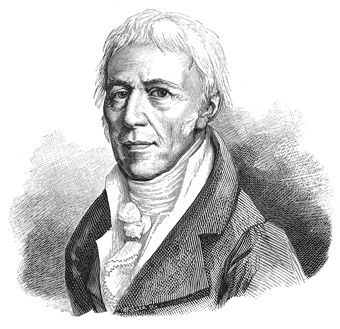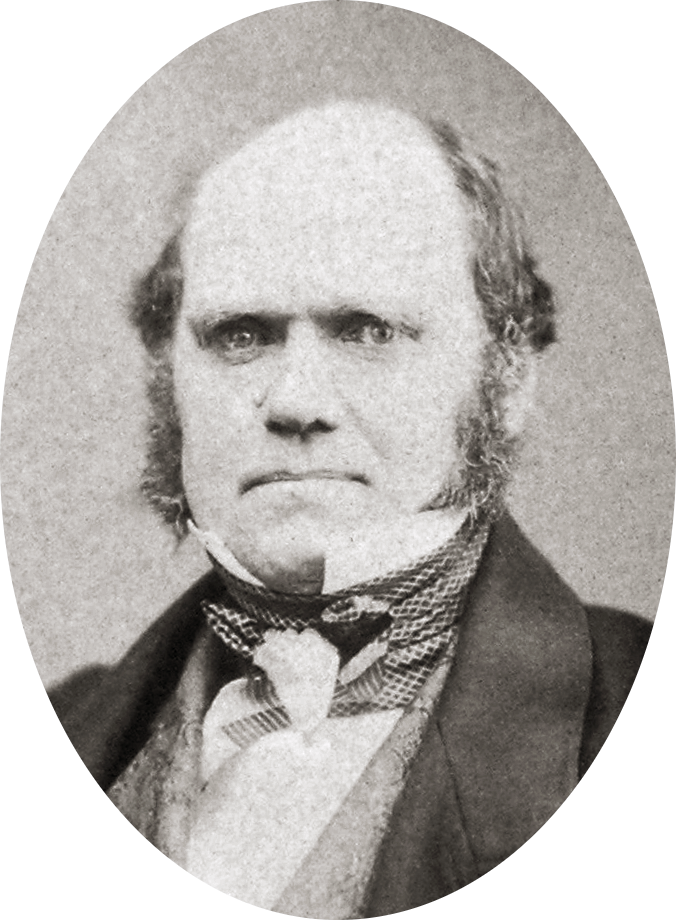A BRIEF HISTORY OF EVOLUTIONARY THOUGHT : MODERN TIMES
 Lamarck (1744 - 1829), also a naturalist, suggested the theory of ‘the inheritance of acquired characteristics’, according to which the effects wrote by the environment on an organism are transmitted to the offspring. He believed that the activity of an animal enhanced the development of the most frequently used structures, producing modifications that are inherited; lack of use led to degenerative changes, which were also inherited. Unfortunately no critical evidence has been produced in favour of Lamarckism.
Lamarck (1744 - 1829), also a naturalist, suggested the theory of ‘the inheritance of acquired characteristics’, according to which the effects wrote by the environment on an organism are transmitted to the offspring. He believed that the activity of an animal enhanced the development of the most frequently used structures, producing modifications that are inherited; lack of use led to degenerative changes, which were also inherited. Unfortunately no critical evidence has been produced in favour of Lamarckism.
 Darwin (1809 - 1882) came after Lamarck. He published the book ‘The Origin of Species’ and immediately got world recognition. Darwin’s theory of evolution was a whole bundle of theories, and it is impossible to discuss Darwin's evolutionary thought constructively if one does not distinguish its various components. The two components would be the evidence of evolution and the mechanism of evolution. Darwin presented evidences for evolution from taxonomy, embryology, comparative anatomy, geographical distribution of species and from fossil records. He presented natural selection as the mechanism of evolution. He said that since individuals differ from each other, some will inevitably be better adapted to survive under the existing conditions than others. The better adapted has more chance to reach maturity and reproduce than the less adapted. Thus in the next generation the percentage of the well adapted will be more. Hence, in time, this natural selection process will change the average characteristics of the given species and evolution would have occurred. The major weakness in the theory of natural selection was the lack of understanding of variation and its mode of transmission from generation to the next. The basic principle of heredity was known, but they were understood apparently only by their discoverer, Mendel (1822 - 1884). Darwin did not come across Mendel’s work. The laws of inheritance lay neglected from 1860 to 1900. After its rediscovery the laws were at first used to argue against natural selection but later Darwin's theory became reconciled with the facts of genetics and the new theory was called ‘The Evolutionary Synthesis’ or ‘The Modern Synthesis’. The theoretical foundations for evolutionary genetics were laid down in 1908 independently by Hardy and Weinberg and subsequently developed by Fisher (1890 – 1962) and Haldane (1892 – 1964) in England and by Wright in the US. Though there are heaps of evidences supporting The Evolutionary Synthesis, it yet remains but a theory of evolution.
Darwin (1809 - 1882) came after Lamarck. He published the book ‘The Origin of Species’ and immediately got world recognition. Darwin’s theory of evolution was a whole bundle of theories, and it is impossible to discuss Darwin's evolutionary thought constructively if one does not distinguish its various components. The two components would be the evidence of evolution and the mechanism of evolution. Darwin presented evidences for evolution from taxonomy, embryology, comparative anatomy, geographical distribution of species and from fossil records. He presented natural selection as the mechanism of evolution. He said that since individuals differ from each other, some will inevitably be better adapted to survive under the existing conditions than others. The better adapted has more chance to reach maturity and reproduce than the less adapted. Thus in the next generation the percentage of the well adapted will be more. Hence, in time, this natural selection process will change the average characteristics of the given species and evolution would have occurred. The major weakness in the theory of natural selection was the lack of understanding of variation and its mode of transmission from generation to the next. The basic principle of heredity was known, but they were understood apparently only by their discoverer, Mendel (1822 - 1884). Darwin did not come across Mendel’s work. The laws of inheritance lay neglected from 1860 to 1900. After its rediscovery the laws were at first used to argue against natural selection but later Darwin's theory became reconciled with the facts of genetics and the new theory was called ‘The Evolutionary Synthesis’ or ‘The Modern Synthesis’. The theoretical foundations for evolutionary genetics were laid down in 1908 independently by Hardy and Weinberg and subsequently developed by Fisher (1890 – 1962) and Haldane (1892 – 1964) in England and by Wright in the US. Though there are heaps of evidences supporting The Evolutionary Synthesis, it yet remains but a theory of evolution.
 Lamarck (1744 - 1829), also a naturalist, suggested the theory of ‘the inheritance of acquired characteristics’, according to which the effects wrote by the environment on an organism are transmitted to the offspring. He believed that the activity of an animal enhanced the development of the most frequently used structures, producing modifications that are inherited; lack of use led to degenerative changes, which were also inherited. Unfortunately no critical evidence has been produced in favour of Lamarckism.
Lamarck (1744 - 1829), also a naturalist, suggested the theory of ‘the inheritance of acquired characteristics’, according to which the effects wrote by the environment on an organism are transmitted to the offspring. He believed that the activity of an animal enhanced the development of the most frequently used structures, producing modifications that are inherited; lack of use led to degenerative changes, which were also inherited. Unfortunately no critical evidence has been produced in favour of Lamarckism. Darwin (1809 - 1882) came after Lamarck. He published the book ‘The Origin of Species’ and immediately got world recognition. Darwin’s theory of evolution was a whole bundle of theories, and it is impossible to discuss Darwin's evolutionary thought constructively if one does not distinguish its various components. The two components would be the evidence of evolution and the mechanism of evolution. Darwin presented evidences for evolution from taxonomy, embryology, comparative anatomy, geographical distribution of species and from fossil records. He presented natural selection as the mechanism of evolution. He said that since individuals differ from each other, some will inevitably be better adapted to survive under the existing conditions than others. The better adapted has more chance to reach maturity and reproduce than the less adapted. Thus in the next generation the percentage of the well adapted will be more. Hence, in time, this natural selection process will change the average characteristics of the given species and evolution would have occurred. The major weakness in the theory of natural selection was the lack of understanding of variation and its mode of transmission from generation to the next. The basic principle of heredity was known, but they were understood apparently only by their discoverer, Mendel (1822 - 1884). Darwin did not come across Mendel’s work. The laws of inheritance lay neglected from 1860 to 1900. After its rediscovery the laws were at first used to argue against natural selection but later Darwin's theory became reconciled with the facts of genetics and the new theory was called ‘The Evolutionary Synthesis’ or ‘The Modern Synthesis’. The theoretical foundations for evolutionary genetics were laid down in 1908 independently by Hardy and Weinberg and subsequently developed by Fisher (1890 – 1962) and Haldane (1892 – 1964) in England and by Wright in the US. Though there are heaps of evidences supporting The Evolutionary Synthesis, it yet remains but a theory of evolution.
Darwin (1809 - 1882) came after Lamarck. He published the book ‘The Origin of Species’ and immediately got world recognition. Darwin’s theory of evolution was a whole bundle of theories, and it is impossible to discuss Darwin's evolutionary thought constructively if one does not distinguish its various components. The two components would be the evidence of evolution and the mechanism of evolution. Darwin presented evidences for evolution from taxonomy, embryology, comparative anatomy, geographical distribution of species and from fossil records. He presented natural selection as the mechanism of evolution. He said that since individuals differ from each other, some will inevitably be better adapted to survive under the existing conditions than others. The better adapted has more chance to reach maturity and reproduce than the less adapted. Thus in the next generation the percentage of the well adapted will be more. Hence, in time, this natural selection process will change the average characteristics of the given species and evolution would have occurred. The major weakness in the theory of natural selection was the lack of understanding of variation and its mode of transmission from generation to the next. The basic principle of heredity was known, but they were understood apparently only by their discoverer, Mendel (1822 - 1884). Darwin did not come across Mendel’s work. The laws of inheritance lay neglected from 1860 to 1900. After its rediscovery the laws were at first used to argue against natural selection but later Darwin's theory became reconciled with the facts of genetics and the new theory was called ‘The Evolutionary Synthesis’ or ‘The Modern Synthesis’. The theoretical foundations for evolutionary genetics were laid down in 1908 independently by Hardy and Weinberg and subsequently developed by Fisher (1890 – 1962) and Haldane (1892 – 1964) in England and by Wright in the US. Though there are heaps of evidences supporting The Evolutionary Synthesis, it yet remains but a theory of evolution.
No comments:
Post a Comment